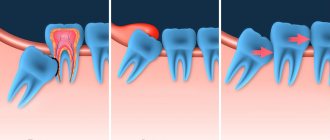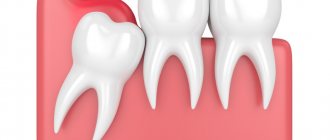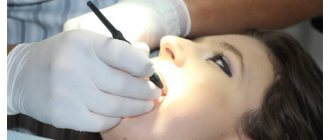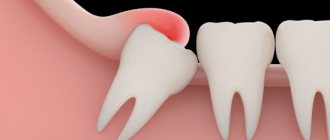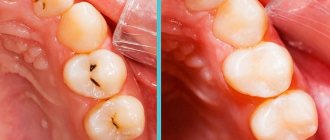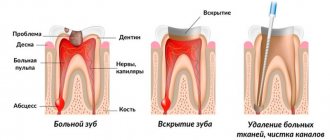From this article you will learn:
- what to do when a wisdom tooth cuts and hurts,
- how to relieve gum inflammation and pain,
- what to do if the eighth tooth grows into the cheek.
When a wisdom tooth grows, its eruption in the jaw is very often overshadowed by inflammation of the gums, which in dentistry is usually called the term “pericoronitis.” Of the permanent human teeth, wisdom teeth are the last to erupt - most often this happens at the age of 18-21 years and even older. This distinguishes them from all other permanent teeth, which erupt between the ages of 6 and 13. But the growth and eruption of these teeth also has several other interesting features.
For example, the formation of the rudiments of wisdom teeth occurs in the jaw not during the period of intrauterine development of the fetus (as happens in all normal permanent teeth), but only after the birth of a child - at about 4-5 years. After this, the slow process of their formation begins, and if the crown part of the wisdom tooth completes its formation by the age of 12, then the formation of the roots ends only by the age of 24. Accordingly, the eruption of wisdom teeth usually begins during the period of root formation.
How a wisdom tooth grows (photo, x-ray) –
Very often, patients complain that their wisdom teeth take forever to grow and their gums hurt. The duration of the eruption process may vary, and primarily it depends on the availability of free space at the end of the dentition. If there is not enough space for eruption, the wisdom tooth will rest against the 7th molar in front, and then the eruption process may be delayed. The fact is that the eruption of a wisdom tooth in the direction of the 7th tooth leads to a gradual displacement of the latter (as well as all other teeth in front) - towards the center of the dentition. This will cause crowding of the front teeth.
Moreover, in some cases, the 8th tooth can grow at a strong angle to the 7th tooth - even if there is sufficient space for eruption. In this case, the wisdom tooth rests against the neck of the 7th tooth with the front part of the crown, and therefore only the distal cusps of the crown part of the tooth are often visible above the mucous membrane (in Fig. 1 you can see what the same tooth looks like on an x-ray and in the oral cavity) . Pain in such situations can be caused both by inflammation of the gums above the wisdom tooth and by its pressure on the teeth in front.
Do we need wisdom teeth?
I use the only compound word. In biology there is such a concept as RUDIMENT
- a part of the human body that has lost its function in the process of evolution. The most famous rudiment is the vermiform appendix of the intestine or appendix. So - a large number of doctors and people believe that there is nothing superfluous in the body and wisdom teeth can serve a person at an older age, when the loss of basic teeth occurs and the doctor can use figure eights to install, for example, a bridge.
Unfortunately, in most cases this is impossible and even wrong!
Most people simply do not have room in the jaw for eighth teeth, and Mother Nature begins to mock them (and, naturally, us doctors) in every possible way: painful eruption, irregular shape, incorrect size of the tooth itself, poorly developed root system - all of the above leaves no chance for the correct use of “eights”.
How wisdom teeth are formed
Unlike other teeth, the rudiments of wisdom teeth are formed not during intrauterine development, but at 3–5 years, when the child’s body is preparing to replace milk teeth with permanent dentition. At this age, you can determine the number of future eights (and there can actually be from one to four). But at this age, it is not yet possible to detect any possible developmental pathologies.
It becomes more or less clear a little later, the crown part of the wisdom teeth begins to form. The formation process starts in a child at about 12 years of age, but the development of the root part of the figure eight takes several more years and can continue even after tooth eruption. Considering that the most common age for the appearance of wisdom teeth is 18–25 years, the eruption of eights occurs already in adulthood. It’s not for nothing that I said earlier the phrase “actually from one to four,” since approximately 10–15% have no eights at all. That is why it is normal to consider the number of teeth in an adult to be from 28 to 32. Those are wisdom teeth, right? How unwise they treat us and make puzzles!
Correct your bite or dental defect with invisible aligners Find out what it is
Types of pericoronitis
Depending on the complexity and localization of inflammation, pericoronitis is divided into:
- Spicy.
The initial stage of the disease, which is characterized by pain, hyperemia and swelling of the gums. In case of acute pericoronitis of a wisdom tooth, there is no purulent discharge and the general condition of the patient does not suffer. With proper timely treatment, this type of disease disappears in 3-5 days.
- Ulcerative.
The disease develops against the background of epithelium damaged by fusospirochetes. A characteristic symptom of ulcerative pericoronitis is the appearance of a necrotic rim along the edges of the gums. Small ulcers form on the mucous membrane. When plaque is removed from the gum surface, bleeding begins.
- Purulent
Pericoronitis, as a rule, occurs in a subacute form and is manifested by severe pain. Pus is released from the source of inflammation, and the temperature rises. In the absence of timely treatment, the disease can provoke the formation of abscesses, phlegmon and periostitis.
- Posteriormolar.
The disease develops when molars erupt incorrectly. A gingival hood forms, which then becomes infected due to the active proliferation of bacteria.
Cutting out wisdom teeth is a real headache
The “birth” of a wisdom tooth in the oral cavity is always painful. The main reasons for the painful effect are thick walls of the dental sac, thickened mucous membrane and reduced growth-forming factors. In addition to the painful process itself, teething can cause many other complications. Which ones? Let's talk about this in a little more detail.
The wisdom tooth sometimes does not erupt completely, crowding the surrounding teeth. This situation usually entails local inflammation and pain.
The time during which a wisdom tooth is cut can be quite long, and inflammation can constantly bother you, manifesting itself as an increased temperature of the whole body and sensitive pain, which sometimes makes it difficult to even just open your mouth! This condition is fraught with inflammation of the tissues surrounding the problematic tooth, right down to the bone, and therefore requires immediate intervention by a qualified dentist.
The first problem with teething eights is caries.
Often, while a wisdom tooth is growing, it is difficult to effectively clean it (due to the location of the wisdom teeth deep in the jaw). This is how caries occurs. Incorrect positioning of wisdom teeth during eruption also increases the risk of tooth decay on the adjacent tooth due to difficulty accessing the spaces between these teeth. If symptoms of caries appear, you must consult a dentist and carry out appropriate treatment. Very often in this case, it is recommended to remove the wisdom tooth, especially if all other teeth are developed normally.
In practice, it happens that a wisdom tooth erupts already... sick, that is, it becomes infected with caries while still in the gum. In such cases, the figure eight should be removed immediately so that the diseased wisdom tooth does not negatively affect the remaining teeth.
The second problem is a cyst
In rare cases, a cyst and tumor may develop in the tissues surrounding an erupting wisdom tooth, which requires immediate surgical intervention by a dental surgeon.
The third problem is malocclusion
If the position of a wisdom tooth is incorrect during eruption, there is a high probability that such a tooth will significantly affect the position of the remaining teeth, which causes a change in the bite. And aesthetic problems arise - the teeth begin to stand crooked in the mouth. And this entails orthodontic treatment, bringing the dentition in order.
The fourth problem is tongue dysfunction
In addition to aesthetic problems, this can also cause functional problems. For example, if a wisdom tooth is displaced towards the vestibule of the oral cavity, serious injury to the mucous membrane of the cheeks, lips or tongue can occur, causing the appearance of erosions and ulcers.
Fifth problem - the wisdom tooth wanted to erupt, but could not erupt
Rarely, a situation occurs when, due to a lack of space in the dentition or in the case of an incorrect inclination of the wisdom tooth itself, an anomaly develops, called a “submerged wisdom tooth.” Such “submerged” teeth are usually removed.
It is possible that the wisdom tooth does not erupt
at all. Despite its absence, such a tooth is dangerous due to its complications. It can damage the roots of neighboring teeth or provoke neuralgic pain. In this case, you need to contact a surgeon and, most likely, the figure eight will have to be removed.
The sixth problem is pericoronitis
At the moment of eruption of the lower (!) wisdom teeth, when only part of the tooth has appeared, acute inflammation and even accumulation of pus in the formed hood between the gum and tooth can occur. This causes a serious disease called pericoronitis (pericoronitis).
The main symptoms of the inflammatory process during pericoronitis are pain and swelling of the gums surrounding the wisdom tooth, bad breath and an unpleasant taste.
If these symptoms appear during the eruption of a wisdom tooth, you should urgently consult a dentist.
The seventh problem of wisdom teeth is periodontitis
When the figure eight erupts quite smoothly, due to its inconvenient location during brushing, the wisdom tooth is not properly cleaned of plaque. Removing tartar and plaque on this tooth in dentistry is also problematic. Because of this, bacteria begin to accumulate around the wisdom tooth, causing inflammation of the gums - periodontitis, which can then develop into osteoperiostitis. In this case, the tooth must be removed.
In what cases is it better to remove a tooth?
Old school dentists insist that at the first discomfort of the patient, wisdom teeth should be removed without regret. Modern dentistry is more humane and is convinced of the need for strict indications for the procedure, rightly noting that in due time “eights” may become the only possible support for dentures.
Indications for removal are:
- eruption of the third molar outside the dentition;
- threat of displacement of adjacent teeth;
- abnormal position of the crown and pressure on the second molar;
- impossibility of therapeutic treatment of the tooth.
Today, at the first visit with complaints of pain caused by the “eight”, the dentist first takes an x-ray to examine the position of the roots, the shape of the tooth and its condition. And only then evaluates all the risks. With this approach, a wait-and-see tactic is increasingly being chosen: the doctor selects painkillers that will help survive the pain that is natural to the teething process. If necessary, incises the gum and cuts off the hood. And then for several months he observes how the wisdom tooth will behave.
Dentists of the Israeli school even fight for impacted wisdom teeth, pulling them out and putting them in the right place with the help of orthodontic instruments. The main thing is that there is enough space in the patient's jaw.
Is it painful to have a wisdom tooth removed?
26% of operations to remove “eights” are no different from the removal of other molars. The wisdom tooth is simply pulled out using hand forceps after local anesthesia is administered. In this case, the patient, as a rule, does not even have time to get scared, the whole procedure goes so quickly.
Another thing is difficult removal. This operation can last up to 40 minutes, during which the surgeon saws the tooth with a drill and takes it out in parts. Unfortunately, this is the only way to remove a tooth that lies horizontally, or has frozen in its development, and has not erupted, but due to its location causes constant pain.
And even in this case, modern anesthesia can completely relieve pain. The same applies to the recovery period. First, in most cases, the surgeon will stitch up the resulting wound, speeding up the healing process. Secondly, he will prescribe painkillers for the coming days. Therefore, you should not be afraid of removal - it will cause much less pain than regular exacerbations.
You can get a quality consultation on wisdom teeth in your city
I want to check my eights!
Treat or remove eights?
Now regarding orthodontic treatment and wisdom teeth. Believe me, it is very unpleasant for us doctors, as well as for patients, to make radical decisions. But there are good reasons! These are your own stories. Stories of patients who underwent treatment with braces as teenagers, achieved excellent results and...
All the beauty of straight teeth, especially the lower incisors (you just started to enjoy a beautiful smile) - it disappears at 20 and beyond. It is when most of us fully develop these “eights”. Two, three and even four years of therapeutic “torment” to correct crooked teeth, transform them into a beautiful/sweet/courageous smile, as they say, down the drain... Yes, yes - the only option to become the owner of beautiful teeth again is repeated orthodontic treatment. It doesn’t matter whether it’s aligners or braces again, the important thing is that there is a good saying: forewarned is forearmed! No one is immune from mistakes and relapse.
Our body is beautiful and magical in that it almost always adapts and compensates for almost any pathology. Therefore, the “eights” cut through with difficulty and subsequently deform
there are very important teeth in front!
Method for removing a horizontally lying figure eight
Any position of a wisdom tooth identified as a deviation from the norm implies an unambiguous recommendation for complex removal. The operation falls into this category because it requires a series of traumatic actions for the patient to extract the tooth completely.
The intervention can be complicated by various unpleasant consequences, so before the operation the surgeon carefully prepares and calculates possible options for the development of the situation. An X-ray is mandatory.
Most dentists vote for early removal of the impacted figure eight. Over the years, the molar roots grow strongly and the jaw bones become denser, which prevents the tooth from being quickly removed from the socket. In youth, tissues are restored faster, and discomfort is experienced more easily.
However, the complexity of the operation is quite surmountable, and it occurs under strong anesthesia. The patient does not experience pain during removal.
Can you put a crown on a wisdom tooth?
Step-by-step method for extracting a horizontally located wisdom tooth:
- The use of an anesthetic, the drug “Ultracaine” is mainly used;
- Making an incision in the gum to expose an impacted wisdom tooth;
- If access to the roots is difficult, sawing the bone is necessary. The manipulation is performed extremely carefully, without the risk of damaging the adjacent tooth;
- Application of forceps and removal of the figure eight using loosening technology;
- When the third molar is in a recumbent position, the dentist first saws the tooth into pieces and removes them piece by piece;
- Suturing the incision on soft tissues with the application of a cotton-gauze swab. If self-absorbable suture material is used, no further treatment of the wound is required. In case of direct suturing, the sutures are removed at a doctor’s appointment in the clinic.
At the last stage of the operation, ice is applied to the extraction area, thus preventing the formation of severe swelling of the gums. The doctor discusses the possible consequences of the intervention: increased temperature, tissue soreness due to injury, bleeding. In this case, the normal limits are indicated, if exceeded, you should immediately contact the clinic.
So what do we do with eights?
The moral of this story is this: trust qualified and educated doctors, not kind and humane “neighborly” advice. Be wise. Especially at such crucial moments in life, when wisdom teeth make themselves felt. And in general, I wonder who was the first to call them “wisdom teeth”?
Moreover, an interesting point from medical practice: if you (what if?) decide to remove the eights, it is not a fact that they will be removed for you. The reason is simple - wisdom teeth must be removed exactly according to indications. A normal doctor will never remove a healthy tooth just because you want it.
You have decided to remove your wisdom teeth. How traumatic is this?
If the wisdom tooth has grown normally, its roots are not intertwined, removal usually takes place without any complications. The edges of the tooth socket after extraction are often not even sutured.
What is most important after removing the figure eight is to allow the socket of the just removed wisdom tooth to heal. Quite a big wound.
What is absolutely impossible to do?
You should not rinse vigorously, even with such seemingly beneficial solutions as chamomile or calendula.
What needs to be done.
To get rid of food debris, you need to carefully take water into your mouth and do short oral baths without intensive rinsing. Instead of water, you can use a solution of chlorhexidine, miramistin or analogs specially sold in pharmacies - they disinfect the oral cavity. And so - for at least three days. If this recommendation is neglected, the hole may become inflamed. Then the dentist prescribes treatment with medications, including antibiotics.
What if the roots of an insidious wisdom tooth are intertwined or fused?
Unfortunately, in this case complications cannot be ruled out - soft tissues may be damaged. If an inflamed tooth is removed, in rare cases the neurovascular bundle (!) of the lower jaw is injured. In this case, separate treatment may be required.
Symptoms and signs of abnormal growth
It is extremely rare for eights to appear without any complications. This is due, first of all, to the fact that wisdom teeth grow in adulthood, when the jaw is already formed. Even with proper teething, discomfort may still be present for several weeks or months. If a wisdom tooth grows incorrectly or has an abnormal location, then certain symptoms indicate this.
Let's take a closer look at the types of pathologies and symptoms associated with the growth of wisdom teeth.
- Retention is a pathology in which the third molar is located under the mucous or bone tissue. The main symptoms are severe pain in the gums, as well as the development of an inflammatory process in the gum pocket.
- Dystopia or abnormal position of the tooth. It manifests itself as severe pain, affecting adjacent teeth, and the development of inflammation, including phlegmon or osteomyelitis.
The initial alarming symptoms that a patient may identify when a wisdom tooth grows are:
- Swelling in the cheek area.
- When swallowing, severe pain occurs, radiating to the throat or ear.
- Purulent or bloody discharge.
- Injury to the mucous membrane.
If you detect at least one of the above symptoms during the eruption of figure eights, you must seek the help of a dentist as soon as possible. The doctor will conduct an x-ray and determine whether the wisdom tooth is growing correctly.
When is it advisable not to remove wisdom teeth?
There are situations when the “seventh” or “sixth” chewing teeth must be removed. And in this situation, a wisdom tooth that has grown correctly may still be useful. It will become one of two supports for the future bridge. However, in this case, a healthy sixth (or fifth) tooth will suffer, because it will have to be treated for an abutment crown.
Now a little about sad things
. 10-15 years will pass, the bridge will “work out” its required operating time. And sometimes it will no longer be possible to insert an implant - the atrophied jaw bone under the bridge will not allow it: in the absence of teeth, any person develops edentulous bone tissue. Thus, on the horizon of life there appear removable jaw dentures and newfangled gels that make them easier to wear.
Now a little about the positive
.
In such situations, you can initially consider dental implantation in specialized
medical centers, where they will help restore bone volume and take control of the dental situation.
Duration of figure eight eruption
The process is long and painful. Since they erupt in adulthood, the bone tissue is formed, it is harder for the tooth to pass through the bone. If there is a place on the jaw, it appears painlessly. If it is not enough, the person faces difficulties. Let's look at the signs that indicate problems with wisdom teeth. When a wisdom tooth breaks through the bone, the symptoms are as follows:
- Painful sensations and swelling. During chewing, unpleasant sensations arise.
- When the tooth does not cut through the gum, it lifts it and forms a hood. When food and bacteria enter, inflammation develops.
- Sore throat often occurs as a result of inflammation spreading to nearby tissues.
- Unpleasant sensations in the ear, including otitis media or otalgia.
- Along with eruption, the lymph nodes become inflamed and lymphadenitis occurs.
- It happens that the figure eight, the eruption of which is just beginning on the gum, is partially located in the mandibular canal.
- There is a feeling of stiffness that extends over half of the head.
- If the dentition becomes crooked, there is no room left for the eighth molar. It will not fall out, but will move the formed row and make room for itself.
What do we do after removing the eights?
We evaluate the possible damage that figure eights could cause to neighboring teeth. If the adjacent teeth are deformed, then the pathology may spread like a domino effect, and here it is already necessary to carry out systemic orthodontic treatment aimed at correcting the disturbed bite.
The most gentle and aesthetic type of dental correction today is aligners. The site provides a lot of information on aligners, but I would like to mention one undeniable advantage, namely, the patient can see the result of his treatment with aligners without even starting it! How so, you ask? The answer is simple - all future treatment of the patient is calculated using modern computer technology. The example below shows a real clinical case, a patient with crowded teeth caused precisely by the pathological effect of “eights” on neighboring teeth.
How to eliminate pain and discomfort
In the absence of pathologies, it is possible to eliminate pain by taking painkillers Nurofen and Ibuprofen. Ideally, consult your dentist before using anesthetics.
It is impossible to accelerate growth or influence the process, but you can facilitate it by cutting the gum. The decision about surgery is made by the dentist based on the clinical picture.
Minor inflammations can be easily removed by rinsing the mouth with antiseptic compounds and herbal decoctions. Otherwise, all you have to do is wait for the tooth to erupt. A consultation with a specialist will allow you to identify deviations in time and prevent risks.
Let's see how wisdom teeth led to crowded teeth
And how crowded teeth are eliminated with Star Smile aligners
The video shows how the 3D setup is done. I am commenting on the video, orthodontist Alexander Spesivtsev, clinical director of Star Smile, a doctor with many years of experience in the successful use of aligners in orthodontic practice. To restore straight dentition, the wisdom teeth themselves—the eights—had to be removed. At Star Smile, or rather in the clinics of its partners (more than 70 cities in Russia), any treatment begins with diagnosis and drawing up a virtual setup. The doctor takes photographs of the patient’s face, dentition, as well as x-rays and dental casts. Using special software, the obtained data is processed and a three-dimensional model of the patient’s dental system is obtained. And this already allows you to calculate the trajectory of tooth movement, treatment time, and the required number of sets of aligners. Also, the final result of the treatment will be visualized - the patient will be able to evaluate the aesthetics of the smile after treatment. Patients really like this approach - they can see their future smile, their straight teeth. The forecast of a 3D setup when straightening teeth with aligners comes true in almost 100% of cases. You see, this is completely different from correcting a “blind” bite, as is usually the case with braces. Everything is clear here, without any guesswork or assumptions.
Gevorkyan Oscar Vladimirovich
Candidate of Medical Sciences, Oral and Maxillofacial Surgeon, Central Scientific Research Institute, Scientific Consultant Star Smile “ If you are faced with questions
:
- To remove or not to remove wisdom teeth?
- How dangerous is it to remove wisdom teeth?
- When do wisdom teeth interfere with orthodontic treatment?
- and most importantly, is it possible to avoid the removal of “eights”?
Feel free to contact the doctors at Star Smile, they will help you understand this sometimes complex, but very important life problem for many.
Do not delay the decision in order to avoid possible complications in the future.” Since the Star Smile company is represented in all federal districts, large and medium-sized cities of Russia and interacts with many clinics and orthodontists, we offer you the opportunity to undergo a free consultation with high-quality orthodontists in your city , where you can discuss the problem of wisdom teeth and determine the optimal solution for you. To do this, you need to fill out the form below, a Star Smile medical specialist will contact you and help you by scheduling a consultation at a convenient time or providing your doctor’s contact information.
Don’t put off the problem of wisdom teeth “for later”!
Emergency measures
What to do if your wisdom tooth is cutting out and your gums hurt? It is not always possible to consult a specialist at the first pathological signs. It is also possible to relieve discomfort at home. To do this, the oral cavity is rinsed with soda or saline solutions. They will help slow down the spread of pathogenic flora and reduce the intensity of inflammation. Solutions are prepared according to the following recipe: 1 tsp. soda or salt is dissolved in 200 ml of boiling water. The rinsing procedure is carried out every 2 hours.
If the cheek is swollen due to caries, then it is better to use herbal tinctures and decoctions. The ideal option is crushed horsetail mixed with honey. To rinse the mouth if there is a problem, use an alcoholic tincture of fennel and horseradish: the plants are crushed and mixed in equal proportions. Plant materials are poured with vodka and left for 3-4 hours. The use of alcohol tinctures is prohibited for patients who have ulcers in the mouth. Otherwise, emergency measures will lead to burns of the mucous membranes.
Freshly squeezed onion juice will help temporarily relieve pain during wisdom tooth growth. A gauze swab is moistened in the product and applied to the problem area for 2-3 minutes.
What painkillers can be used if a wisdom tooth is coming out and your cheek hurts? In this situation, potent tablets, which are usually prescribed by a doctor, are suitable. When taken independently, side effects may develop, such as stomach bleeding or lack of effect from taking the medication. For this reason, taking painkillers for more than 3-5 days without consulting a doctor is prohibited.
A common group of medications used for toothaches are analgesics. Medicines provide a calming effect for several hours before visiting the dentist. From this group of drugs Analgin, Pentalgin, Tempalgin are used. Ibuprofen-based products - Nurofen, Nimesil, Bonifen - have a more powerful therapeutic effect. The drugs not only reduce pain, but also have an anti-inflammatory effect.
Aspirin and Paracetamol will help relieve suffering. You should not count on a powerful pain-relieving effect from taking these medications.
What does a wisdom tooth look like?
List of the most powerful drugs used for pain in the cheek during teething:
- Nise;
- Ketarol;
- Ketanov;
- Nimesil;
- Ketorolac.
The effect of taking the drug lasts for a long time, more than 4 hours. Frequent use of the above medications threatens complications from internal organs.
If the cause of the problem is related to the eruption of a rotten third molar, then an anesthetic can be applied to the tooth. To do this, the tablet is crushed into powder and poured into the carious cavity. It is necessary to ensure that the drug does not get on the gums and mucous membranes, otherwise even greater inflammation may develop.
To treat carious lesions, it is most convenient to use Lidocaine spray. The drug is sprayed on the side on which pain is noted.
Cooling gels - Cholisal, Kamistad, Dentol, Metrogyl - will help temporarily cope with the signs of a growing figure eight. Additionally, the sore spot is rinsed with antiseptics - Miramistin, Chlorhexidine, Furacilin.
What to do if your cheek is swollen from a wisdom tooth, and you don’t have the appropriate medications at hand? You can soak a cotton swab in propolis tincture or valerian and apply it to the problem area. You can rinse your mouth with vodka (in the absence of ulcers and open wounds on the mucous membranes). Sea buckthorn oil has a good anti-inflammatory and analgesic effect. It does not damage the mucous membranes and is considered safe in the treatment of toothaches.
Medication assistance at home
If the pain is very severe and folk remedies no longer give results, then you can take painkillers - Nurofen, Ketanov, Ketanol. The effect of taking the pill comes quickly, but does not last long (1-5 hours). There have been cases when painkillers do not help and a person takes an increased dose to get rid of pain, drinking a handful of tablets in a short time, which in turn can lead to serious consequences. In this case, it is recommended not to increase the dose, but to change the medicine to a similar one.
To reduce pain, oral and maxillofacial surgeons use the more expensive drug Ecoricoxib, which has a long-lasting analgesic and anti-inflammatory effect. The instructions for its use do not say anything about teeth, but it relieves pain from the eruption of wisdom teeth very well. It is enough to take one tablet per day.
To reduce pain, you can rinse your mouth with weak solutions of Eludride and chlorhexidine, which have an antiseptic effect. The Kamistal anti-inflammatory gel also helps; it contains chamomile and lidocaine hydrochloride, which relieves excruciating pain in the gums and bacterial activity under the hood.
This article is for informational purposes only, please consult your doctor for details!


